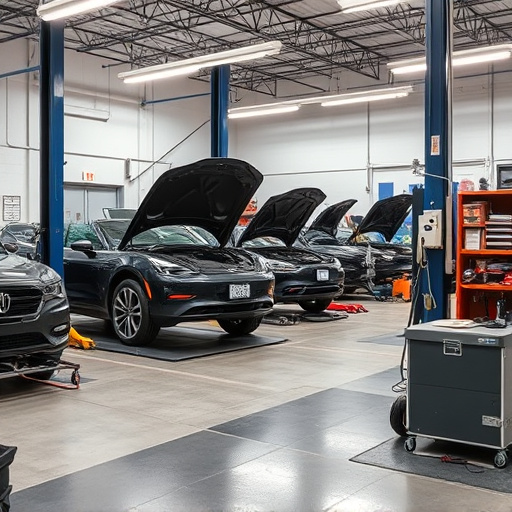Tesla's advanced Thermal Management System ensures optimal vehicle performance by maintaining consistent internal temperatures, especially in extreme weather. A thorough check involves inspecting sensors, pumps, radiators, and controllers for issues like leaks or blockages, with common solutions including resetting the Thermal System Controller. Regular Tesla thermal management checks are vital for preventing failures, extending battery life, and ensuring passenger comfort through effective climate control.
In today’s digital era, understanding the intricate systems within electric vehicles (EVs), particularly Tesla models, is paramount for optimal performance. This article guides you through the essential process of a Tesla Thermal Management Check and introduces the troubleshooting step of resetting the Thermal System Controller. Learn about the unique thermal management system in EVs, common symptoms requiring a check, detailed steps involved, potential issues discovered, and when/how to perform a controller reset. Master these tasks for enhanced vehicle health.
- Understanding Tesla's Thermal Management System
- – Overview of thermal management in electric vehicles
- – Key components and their functions
Understanding Tesla's Thermal Management System

Tesla’s Thermal Management System is a sophisticated network designed to maintain optimal temperatures within the vehicle, ensuring peak performance and efficiency. This system plays a crucial role in preserving the integrity of electric vehicles’ (EVs) sensitive components, particularly during extreme weather conditions. By monitoring and controlling temperature across various systems, it prevents overheating and ensures a consistent driving experience.
A Tesla thermal management check involves evaluating this intricate network for any anomalies or performance issues. This process is essential for maintaining the overall health of the vehicle, especially in regions with drastic climate changes. If problems are detected, such as inefficient heat distribution or abnormal temperature readings, resetting the Thermal System Controller can help restore optimal functioning. This controller acts as the brain of the thermal management system, coordinating operations between various components like radiators, heaters, and cooling fans to maintain a harmonious internal climate.
– Overview of thermal management in electric vehicles

Thermal management is a critical aspect of electric vehicle (EV) design and performance. Unlike traditional internal combustion engine vehicles, EVs generate power through electricity, which requires efficient cooling systems to prevent overheating. In the case of Tesla vehicles, thermal management involves a sophisticated network of sensors, pumps, and radiators working in harmony to regulate battery temperature. This is essential for maintaining optimal battery life and overall vehicle performance.
A Tesla thermal management check is a routine maintenance procedure that ensures these critical components are functioning correctly. It involves inspecting and testing the vehicle’s liquid cooling system, heat sinks, and thermal system controller to identify any leaks, blockages, or malfunction. Regular checks can help prevent catastrophic failure and extend the life of your EV, which is why many vehicle repair services and even collision repair shops offer specialized Tesla service packages that include thorough thermal management assessments.
– Key components and their functions

The Tesla Thermal Management System is a sophisticated network designed to regulate and optimize the vehicle’s interior climate control. At its core are several critical components working in harmony. The Thermal System Controller (TSC) acts as the central brain, monitoring temperature sensors throughout the cabin and adjusting the heating or cooling systems accordingly. This intelligent controller ensures passenger comfort by managing the flow of refrigerant and air, making adjustments based on real-time data.
Key to efficient thermal management is the heat exchanger, which facilitates the transfer of heat from the interior to the exterior of the vehicle. This component, often overlooked in collision repair services, plays a vital role in maintaining optimal temperatures. Additionally, the cabin air filters are integral to the system, as they capture and remove contaminants, ensuring clean and healthy air circulation during automotive collision repair processes or car scratch repair scenarios, while also preventing debris from blocking the thermal paths.
Tesla’s advanced thermal management system plays a crucial role in maintaining optimal performance and extending battery life in its electric vehicles. Regularly performing a Tesla thermal management check and understanding how to reset the Thermal System Controller can help owners ensure their cars operate efficiently, especially under extreme temperature conditions. By staying proactive with these maintenance tasks, Tesla drivers can contribute to a smoother driving experience and maximize the longevity of their vehicle’s critical components.














